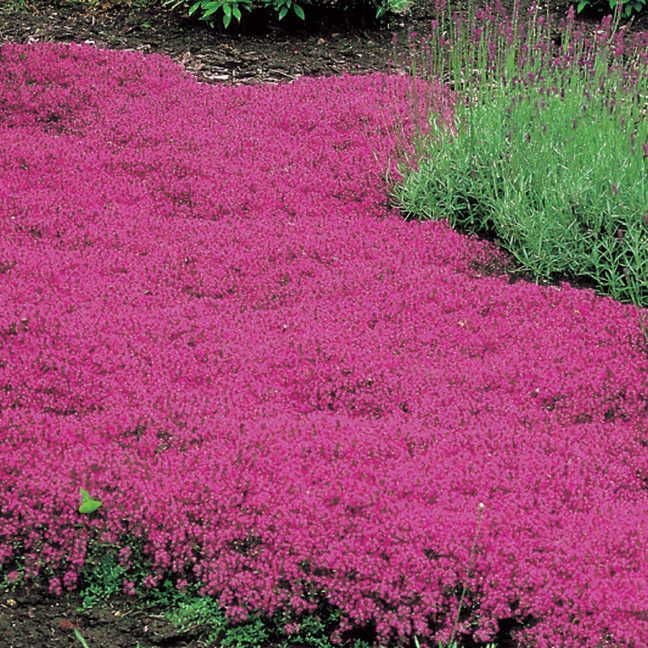
Dharaseeds
Thymus Coccineus Red Creeping Thyme Seeds
Estimated Free Delivery between April 16 and April 19.
Secured Payment Methods
Your transaction is protected with advanced security measures to keep your information confidential
Thymus Coccineus, also known as Red Creeping Thyme, is a low-growing, fragrant herb that adds beauty and versatility to any garden. With its striking red flowers and aromatic leaves, it’s perfect for ground cover, rock gardens, or as an ornamental edging. This hardy perennial thrives in sunny locations and is known for its resilience in various climates, making it an excellent choice for both novice and experienced gardeners. Whether used for its ornamental value or culinary purposes, Red Creeping Thyme is sure to impress.
Key Benefits
- Attractive Ground Cover: Its creeping growth habit makes it an ideal choice for filling in gaps, covering bare soil, or creating a low-maintenance ground cover.
- Vibrant Red Flowers: Produces beautiful red flowers in summer, which attract pollinators like bees and butterflies.
- Aromatic Leaves: The leaves emit a delightful thyme fragrance when crushed or brushed against, making it a great addition to herb gardens.
- Drought-Tolerant: Once established, Red Creeping Thyme is highly drought-tolerant, making it ideal for low-water gardens.
- Versatile Use: Perfect for culinary applications, as well as adding beauty to walkways, borders, and rock gardens.
Variety Features
- Plant Characteristics: Low-growing, mat-forming perennial with tiny green leaves and red flowers.
- Flower Color: Produces small, tubular red flowers in summer.
- Growth Habit: Spreads to form a dense, ground-covering mat, reaching a height of 3–4 inches.
- Size: Typically grows 3–4 inches tall with a spread of up to 12–18 inches.
Planting Instructions
Planting Season
- Start seeds indoors in early spring or sow directly outdoors after the last frost for a summer harvest.
Planting Details
- Seed Depth: Lightly press seeds into the soil, as they require light to germinate, but do not cover them with soil.
- Spacing: Space plants 6–12 inches apart to allow room for spreading.
- Soil Requirements: Prefers well-drained, sandy or loamy soil with a neutral to slightly alkaline pH (6.0–7.5).
- Sunlight: Thrives in full sun and can tolerate light shade in hotter climates.
Care Instructions
Watering
- Water regularly during the first few weeks after planting to encourage root establishment. Once established, Red Creeping Thyme is drought-tolerant and requires little watering.
Fertilization
- Fertilize sparingly with a balanced fertilizer in early spring to encourage healthy growth, but avoid over-fertilizing as it can lead to excessive foliage growth at the expense of flowering.
Weeding and Mulching
- Mulch lightly around plants to retain moisture and prevent weeds, but avoid heavy mulching that may smother the plants.
Pest and Disease Control
Pests
- Red Creeping Thyme is generally pest-resistant, though it may attract aphids or scale insects. These can be managed by spraying with insecticidal soap or introducing natural predators like ladybugs.
Diseases
- Red Creeping Thyme is resistant to most diseases, but root rot can occur in overly wet conditions. Ensure proper drainage and avoid over-watering to prevent this.
Harvesting
Maturity
- Red Creeping Thyme flowers in mid to late summer, and its leaves can be harvested anytime after the plant has become established.
Harvesting Leaves
- Harvest leaves by cutting the stems back just above the woody base. Use them fresh or dry for later use.
Storage
Short-Term
- Store fresh thyme leaves in the refrigerator for up to a week in a sealed container.
Long-Term
- Dry the leaves by hanging them in small bundles in a warm, dry area. Once dried, store in an airtight container away from light for up to a year.
Culinary and Medicinal Uses
Culinary Uses
- Red Creeping Thyme is commonly used in cooking for its strong, aromatic flavor. Use it in soups, stews, roasted meats, and Mediterranean dishes, or as a garnish for various dishes.
Medicinal Uses
- Traditionally, thyme has been used for its antimicrobial and digestive properties. It can be brewed into tea to help with sore throats, coughs, and digestive issues.
Conclusion
Thymus Coccineus Red Creeping Thyme is an excellent choice for gardeners looking for a fragrant, low-maintenance, and attractive ground cover plant. With its beautiful red flowers, aromatic leaves, and ability to thrive in poor soil and dry conditions, this thyme variety brings both beauty and practicality to the garden. Whether you want a drought-tolerant ground cover, a fragrant herb for culinary use, or a pollinator-friendly plant, Red Creeping Thyme is a versatile and valuable addition to your garden.










